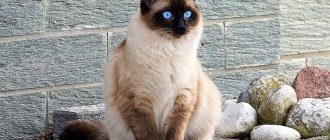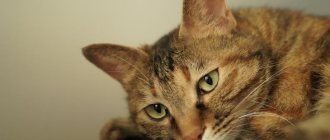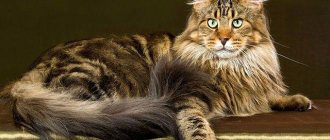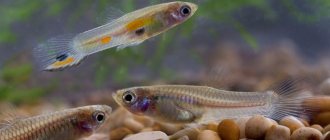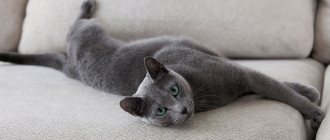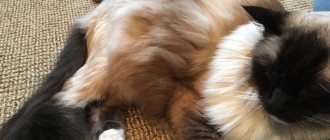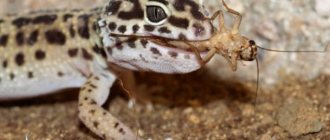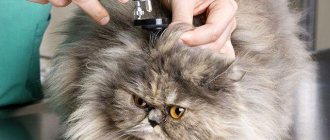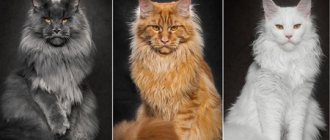Felines are already more than 35 million years old, and according to various estimates, there are now approximately 400 - 600 million domestic cats in the world, and about 260 breeds have been bred.
The number of stray cats is simply impossible to estimate.
In addition, there are 36 wild cat species that live on all continents except Australia and Antarctica.
The geographic service World Atlas has published the top ten countries that have the most domestic cats in the world , with a total of about 200 million cats. (data updated March 1, 2021)
Japan (7.25 million cats)
Since ancient times, the Japanese have had such a loving relationship with cats that these animals have often become major characters in Japanese art and literature.
The country even has its own "Cat Island", namely Tashirojima Island (more commonly called simply Tashiro), which is actually part of Ishinomaki City (Tashirojima Island in Ishinomaki City), where cats thrive in large numbers and can often be found in boating port of the city (since fishermen share their catch with them every day).
This island also has a cat temple, Neko-jinja, where locals worship cats in the hope that they will bring good luck.
Pensioners whose average age exceeds 70 years still live on the “cat islands.” Young people left the islands long ago, moving to large cities. And on the islands cats have no enemies, since there are no dogs there at all.
Another paradise for cats in Japan is Aoshima Island, in Shikoku, where the ratio of cats to people is almost 100:15! These islands are also popular destinations for cat lovers from all over the world. And tourists try their best to feed the growing colonies of cats; many come to communicate and photograph the cats more than once.
In addition, growing cat populations thrive on the streets of Japan's cities and towns, and large numbers of Japanese people own cats as pets.
In many major Japanese cities and towns, cat salons, cat cafes (where people unable to keep cats at home enjoy interacting with animals while relaxing over a cup of coffee) and pet stores (offering a huge range of cat-themed products) abound ).
One of the most popular souvenirs and symbols of Japan are figurines of “calling cats” - Maneki-neko, which bring good luck and wealth.
Recent estimates place the total cat population in Japan at about 7.25 million.
The population of Japan as of 2021 is approximately 126,500,000.
Ukraine (7.5 million cats)
Ukraine has a very large cat population, about 7.5 million.
Although Ukrainian families often keep cats as pets and as protection against rodents, the country is home to a huge number of stray animals.
The treatment of stray cats in Ukraine has often been criticized by international animal protection organizations.
The country also lacks clearly defined laws,
protecting animals and their welfare, which allows large numbers of cats and dogs to be thrown onto the street without any liability on the part of unscrupulous owners.
The population of Ukraine as of March 1, 2021 was 42,371,996 people.
Monument to the cat Panteleimon in Kyiv
Germany (7.75 million cats)
Monument to stray cats in Braunschweig.
Germans love their cats. This is evidenced by data on the number of cats in the country, which is estimated to be about 7.75 million individuals.
The Germans have a great love for cats and strive to surround their pets with comfort, buying them the best dry food, special premium canned food, comfortable beds and claw scratchers in the form of complex trees, and they spend a lot of money on maintaining their pets. German cats are particularly well-groomed; often on the streets of Germany you can see owners walking with their pets on a leash.
However, according to recent government reports, the number of stray cats in Germany is also rapidly increasing, and there are now millions of abandoned animals in the country.
Free-roaming of unneutered cats is the main reason for the steady increase in the stray cat population.
In 2014, the Germans estimated that stray cats caused €500,000 worth of damage to urban green spaces (including trees and flowers) in one year.
However, after a nationwide survey, the German authorities were forced to impose a ban on the destruction of stray animals and limited themselves to introducing strict restrictions on the free walking of domestic cats on the streets of the country.
The population of Germany in 2021 is approximately 81,200,000 people.
Losses on the way to recognition
Here we finally return to our original question, how many cat breeds are there in the world? The fact is that each of the felinological organizations has its own approach to the recognition and assessment of the breed. One may recognize this or that breed, another may distinguish it as a variety of some other breed, and a third may not recognize it at all. For example, the WCF currently recognizes about 78 breeds, while the CFA only recognizes 42 breeds.
How many cat breeds are there?
However, if we consider not only the breeds recognized by felinological organizations, then in fact, there will be much more of them - over 100. The fact is that despite the fact that felinology has a long history, it still remains a hobby, and there are a huge number of enthusiastic breeders who now and then begin to breed new breeds at their own risk. After they manage to get at least some result, they declare their success. But what happens to the breed next is a big question.
Any new breed needs a fairly long period of development until standard animals with pronounced breed characteristics are born in each litter. In addition, this breed must become in demand and withstand competition with other similar ones.
Not everyone manages to go this route, and many breeds exist only nominally, and their breeding is supported by rare enthusiasts. Examples include the Levkoy, Ural Rex, Anatolian cat and many others. It seems that they exist, and on the Internet you will even find their detailed description and standard, but kittens of this breed are very difficult to buy, and you will not see them at major exhibitions. It is difficult to say whether they should be considered breeds in the full sense of the word.
Domestic (mongrel) cats
To find out how many cat breeds currently exist in the world, you need to look at the list of varieties that are recognized by the three largest felinological organizations (WCF, FIFe and TICA):
- 1. Maine Coon.
- 2. Egyptian Mau.
- 3. Abyssinian.
- 4. Peterbald.
- 5. Balinese (Balinese, Bally).
- 6. Siamese.
- 7. Burma (Burmanskaya).
- 8. Cymric.
- 9. Persian (Kolopoint). TICA distinguishes 2 types: Persian and colorpoint, while others consider this to be one cat breed.
- 10. Sacred Burmese.
- 11. Oriental DS.
- 12. Oriental CABG.
- 13. Exotic.
- 14. Norwegian forest.
- 15. Korat.
- 16. American Curl DS.
- 17. American Curl KSh.
- 18. Siberian.
- 19. Kurilian bobtail DS.
- 20. Kurilian bobtail KSh.
- 21. British KS.
- 22. Don Sphynx.
- 23. Devon Rex.
- 24. Manx (Manx cat).
- 25. Cornish Rex.
- 26. Ocicat.
- 27. Russian blue.
- 28. Japanese bobtail DS.
- 29. Japanese bobtail KSh.
- 30. Ragdoll.
- 31. Somalia.
- 32. Bengal.
- 33. Turkish Angora.
- 34. Turkish van.
- 35. Neva Masquerade.
- 36. Canadian Sphynx.
- 37. Chartreuse.
To obtain registration of a cat variety, it is necessary to prove the “right to exist.” Therefore, recognition takes time.
https://www.youtube.com/watch?v=https:accounts.google.comServiceLogin
Organizations may disagree. This leads to the fact that some cat breeds are recognized only by separate groups, and the total number fluctuates:
- WCF considers such varieties as Australian Mist, Tabby (Asian), Anatolian, Arabian Mau, Brazilian KSh, York, Canaani, Karelian Bobtail KSh and DSh, Mekong Bobtail, Ragamuffin, Scottie Straight, Chantilly Tiffany, Ural Rex DSh and KSh. These species are not registered in TICA and FIFe.
- TICA recognizes the following: Minskin, Ojos Azules and Ojos Azules DS, American Bobtail DS and CS, Havana, Pixie Bob CS and DS, Savannah, Serengeti, Toyger and Javanese. WCF and FIFe do not consider these breeds.
- FIFe recognizes Seychelles DS and KS, which others do not allow for registration.
Obviously, no one will deny that domestic cats did not exist in nature. All of them were once wild forest and steppe. Domestication of wild cats began during the period when humans moved from hunting and gathering to agriculture. This is where we really needed helpers to deal with rodents. Since then, man's friendship with hardworking tailed pets and their gradual domestication began.
A purebred cat is one that has a pedigree - an official document issued by a specialized club (abbr. KLK - “club of cat lovers”), which is part of one of the felinological organizations. A purebred cat must have a number of special qualities that meet the standard, which is again drawn up and periodically improved by the felinological organization.
The concept of “standard” usually includes requirements for general physique, coat color and texture, eye color and shape, etc. In addition, the standard often prescribes a number of disqualifying characteristics - undesirable qualities in a breed representative that can have a negative impact on the appearance of future offspring.
Felinological organizations not only develop breed standards, but also control the work of numerous nurseries, establish procedures for holding exhibitions, train experts, etc. The most authoritative organizations are the World Cat Federation (WCF), The Cat Fanciers' Association (CFA), and The International Cat Association (TICA), Fédération Internationale Féline (FIFe) and Governing Council of the Cat Fancy (GCCF).
To find out how many cat breeds currently exist in the world, you need to look at the list of varieties that are recognized by the three largest felinological organizations (WCF, FIFe and TICA):
- 1. Maine Coon.
- 2. Egyptian Mau.
- 3. Abyssinian.
- 4. Peterbald.
- 5. Balinese (Balinese, Bally).
- 6. Siamese.
- 7. Burma (Burmanskaya).
- 8. Cymric.
- 9. Persian (Kolopoint). TICA distinguishes 2 types: Persian and colorpoint, while others consider this to be one cat breed.
- 10. Sacred Burmese.
- 11. Oriental DS.
- 12. Oriental CABG.
- 13. Exotic.
- 14. Norwegian forest.
- 15. Korat.
- 16. American Curl DS.
- 17. American Curl KSh.
- 18. Siberian.
- 19. Kurilian bobtail DS.
- 20. Kurilian bobtail KSh.
- 21. British KS.
- 22. Don Sphynx.
- 23. Devon Rex.
- 24. Manx (Manx cat).
- 25. Cornish Rex.
- 26. Ocicat.
- 27. Russian blue.
- 28. Japanese bobtail DS.
- 29. Japanese bobtail KSh.
- 30. Ragdoll.
- 31. Somalia.
- 32. Bengal.
- 33. Turkish Angora.
- 34. Turkish van.
- 35. Neva Masquerade.
- 36. Canadian Sphynx.
- 37. Chartreuse.
To obtain registration of a cat variety, it is necessary to prove the “right to exist.” Therefore, recognition takes time.
Pedigrees are issued by special clubs of cat lovers. Clubs unite into felinological organizations. Each nursery of purebred cats must be registered with one or more such organizations.
https://www.youtube.com/watch?v=ytdev
It is important to understand the difference between a club and an association of felinologists. Clubs and nurseries are mainly engaged in breeding animals, improving their breed qualities - exterior, color, character. Sometimes they introduce new breeds or color variations, but they must be approved by the large organization to which the club belongs.
These large organizations determine which breeds can be recognized as existing and how cats belonging to them are assessed. All parameters that the animal must meet are also described by felinological associations. In addition, they are in charge of all cat shows, the time and order of their holding.
In addition to a dozen international ones that enjoy honor and respect in any country, there are also many small, “homemade” associations that base their work mainly on deceiving newcomers. Therefore, it is better for nurseries and buyers to cooperate with well-known associations.
This is why it is difficult to unambiguously answer the question of how many cat breeds exist in the world - each association has its own views on this, its own list of recognized breeds.
If we talk about the most prestigious organizations, the WCF has about 70 cat breeds, and the CFA has a little more than forty. In addition, there is a significant difference in the colors of different breeds, of which there are more recognized in some places and fewer in others.
The emergence of new breeds is a labor-intensive task, since it is necessary not only to achieve stability of the acquired characteristics, but also to wait for recognition in prestigious cat associations, and they are distinguished by a certain conservatism. Oddly enough, it is the American systems that turn out to be more strict in this matter, although in other respects they keep up with the times.
We invite you to read: Toy Terrier and Chihuahua, differences between these breeds
Unfortunately, playing on human gullibility and lack of information, many scammers pass off ordinary yard cats as true aristocrats. For example, they offer to buy “a kitten of the rarest color - Abyssinian platinum.” If you decide to get a truly purebred pet, first carefully study the standards, make sure you can distinguish a purebred animal from a fake.
Of course, love is not measured by the purity of blood, but by buying so-called kittens of a rare breed (but in fact, a non-existent one), you support scammers who, without hesitation, throw unsold kittens into the trash heap, and continue this conveyor belt of death for their own benefit.
A real breeder who is passionate about his business takes care of his pets, monitors their lives in their new homes, and is always ready to give advice and help. Such people are busy doing a wonderful job - they improve breeds and create new ones, delighting all cat lovers.
Once upon a time, cats were wild animals. Even now, there are individuals that prefer to live in the steppes and forests rather than near humans. We domesticated them, thanks to which now mustachioed pets calmly coexist with us. Gradually, work is underway to universalize animals, in other words, new breeds are being developed - diverse, having not only different appearance, but also character, habits and other important factors.
https://www.youtube.com/watch?v=ytpress
A breed is a group of animals that differ from other members of a family or species by a set of certain characteristics. It is clear that for each of us who is the happy owner of a funny furry animal, it makes no difference what breed it is. We just love him, and pedigree has nothing to do with it.
A cat is classified as a specific breed if it has and passes on to its offspring traits characteristic of that breed.
| Pedigree | Compliance | No disqualifying features |
| Pedigree refers to documents issued by the relevant club. It can exist only in one case - if the cat is a carrier of all the genetic characteristics of its breed, which are passed on from generation to generation. The pedigree includes a description of the parents. | This refers to external signs, thanks to which you can accurately determine whether an animal belongs to a particular breed. There are quite a lot of such factors:
In addition to these signs, there are many more secondary ones. So matching the breed is not such an easy task for a pet. | The description of the standards necessarily includes positions in which a cat cannot be considered a purebred cat. These are the so-called disqualifying characteristics. For example, an animal is considered purebred, but its ear structure or face shape is different, its color is disturbed, etc. Mostly this is a consequence of a “mongrel” or genetic abnormalities. It is important to understand that not all deviations from accepted breed standards can cause disqualification. Minor defects only reduce the value of the item. This is usually expressed in a reduction in price. Existing defects must be indicated in the documents. |
- unique color and pattern;
- presence or absence of wool and its type;
- length of body, tail and paws;
- skull shape;
- structure of the ears;
- chest width;
- eye color type.
UK (7.75 million cats)
The majority of households in the UK own cats, and UK animal welfare laws are among the most advanced in the world.
And the galaxy of famous cats performing the duties of mousecatchers at the Prime Minister's residence at 10 Downing Street in London (including the famous cat Larry) is the object of close attention of cat lovers in different countries.
Organizations of felinologists
A very difficult question that is not easy to answer: “How many are there in the world?” First you need to figure out how a new breed appears, who can breed it, how and by whom is it registered? A purebred cat has its own pedigree, issued by the club of lovers of these animals, which is part of the professional organization of felinologists. Catteries that breed purebred cats must be registered with professional organizations.
There are a huge number of associations of felinologists in the world, and all of them, in fulfilling their duties, work at the international level. Each association has an excellent reputation and experience in breeding purebred cats. For example, there are the authoritative European association WorldCatFederation (WCF) and the American The CatFanciers' Association (CFA). Each has a list of recognized breeds, but their number is difficult to record.
What does "thoroughbred" mean?
When they say that a cat is purebred, they mean that it has a pedigree, which is an official document provided by the club. The club must be a member of one of the international organizations. A purebred cat meets a certain standard - it has generally accepted parameters (height, weight, appearance features, etc.) that are typical for the corresponding species. But it is subject to change periodically.
In addition to the main characteristics of the species that must be met, the standard describes disqualifying qualities. This is a list of flaws, both in appearance and in health, to which representatives of this breed are prone. The presence of disqualifying qualities listed in the standard does not give the right to individuals to take part in selection due to the high risks of genetic inheritance of defects by subsequent generations.
Italy (9.5 million cats)
While Italy's beloved domestic cats enjoy plenty of perks, stray cats are not far behind. They are allowed to roam freely through the streets of the country under the admiring gaze of their two-legged admirers; Italy has a large number of shelters that do not kill wild and stray cats.
One of the most famous sanctuaries in Italy is the Torre Argentina Cat Sanctuary, located in Largo di Torre Argentina in Rome, where a large number of stray cats of different breeds take the opportunity to stop by to eat and rest before continuing their free lives.
The country also has a large number of Le Gattares - groups of female cat lovers in cities and towns across Italy who are custodians of feral and stray cat populations in their communities. They have special responsibility for feeding and caring for these animals.
The number of domestic cats in Italy is about 9.5 million.
The population of Italy in 2021 was 60,599,936 people.
Types of breeds
When considering the types of purebred cats, it is worth paying attention to their coat. There are short-haired animals: Thai, British, Abyssinian and others. These cats are easy to care for. The coat does not require daily brushing, and they are bathed once every two months. Long-haired cats - Persian, Siberian, Angora - require careful care of their fur, as it quickly rolls into tangles, which bring discomfort to the animal. If these cats are not looked after, they look very untidy.
There are also hairless cats, they are called hairless. These include the Don and Canadian Sphynx, as well as the Ukrainian Levkoy. Caring for such cats is not burdensome. In addition, they are suitable for people who are allergic to wool. But their pets are very afraid of the cold, so these cats should be dressed in the cold season.
How many cat breeds are there in the world, differing in size? There are very small animals. Their weight ranges from 2 to 4 kg for an adult. These are cats of the Toy Bob, Devon Rex, Singapore, and Munchkin breeds. These animals look like small kittens and are very playful. But there are also large purebred specimens, which, according to the testimony of their owners, have a calm character and are nobly beautiful. This breed includes the Maine Coon and Norwegian Forest.
The world (pictured) includes the Serengeti, toyger, and savannah.
Not everyone can afford the pleasure of having a cat that costs several tens of thousands of dollars. Videos are shot about them, photo sessions are done, thanks to this we know about such unique cat breeds.
List of the most popular breeds
The cat breeds popular in the modern world are descended from basic species that some people have never even heard of. To this day, breeders breed new individuals by crossing cats of the main breeds.
Several types of cats are now considered the most popular.
Abyssinian cat
This breed is considered one of the most ancient, because their ancestors were indigenous cats of Africa. Abyssinians were originally called "rabbit cats" because their coat color is very similar to that of wild rabbits.
Externally, Abyssinian cats resemble small pumas - their body is graceful but muscular. The color of the breed can vary from black or red-brown to beige. By type of coat they are classified as shorthaired.
By nature, Abyssinians are very friendly, affectionate and curious. They get along well not only with other members of the cat family, but also with dogs.
Average life expectancy is 18–20 years.
American Bobtail
Cats of this breed were bred in the late 60s of the twentieth century in the USA.
A distinctive feature of the appearance of American Bobtails is their short and very fluffy tail. Based on the type of coat, representatives of the breed are divided into 2 varieties: short-haired and long-haired.
American Bobtails are highly trainable, very active and playful, and love attention from their owner.
Average life expectancy is 11–15 years.
American Curl
Representatives of the breed were bred in 1981 in the American state of California.
A distinctive feature of the appearance of these cats is their ears turned back with a well-furred inner surface. Based on the type of coat, representatives of the breed are divided into 2 varieties: short-haired and long-haired.
American Curls are friendly, but they do not get along well with small children because they do not like to be cuddled. Cats of this breed are very playful and remain active until old age. They quickly adapt to their new environment, making them excellent pets for people who move frequently.
Average life expectancy is 12–15 years.
Bengal
The first representative of the breed was born in 1961 in the USA from the crossing of a wild Bengal cat and an ordinary black domestic cat.
A distinctive feature of Bengals is the so-called “wild” color. Their short, silky, shiny coat has a distinct spotted or marbled pattern of black or brown spots on a golden-orange background.
With regular communication with the owner, the Bengal kitten will grow up to be gentle and loyal, just like ordinary pets. However, genes usually take their toll, so representatives of the breed are ready to hunt almost around the clock for some insect or run after a ball like wild cats.
Average life expectancy is 12–15 years.
Bombay
These cats, despite their name, appeared in the state of Kentucky (USA) in the 50s of the twentieth century.
Bombay looks like a real smaller version of a panther. The fur of representatives of the breed is short, black, smooth, shiny, without spots or hairs of a different color, and the eyes are large and amber.
Affectionate, intelligent and very sociable Bombays rarely meow and do not tolerate loneliness well.
Average life expectancy is 13–16 years.
British cat
Representatives of this breed were bred in the 19th century in Great Britain.
According to the type of coat, British cats come in two varieties: short-haired and long-haired. The coat of both types is considered almost ideal: it hardly sheds, does not mat and does not require much care.
Like true Englishmen, cats of this breed do not like excessive attention and try to spend time alone.
Average life expectancy is 15–20 years.
Egyptian Mau
Another ancient cat breed. The ancestors of the Mau lived more than 3,000 years ago in Ancient Egypt.
A true representative of this breed must have a pattern in the form of the letter “M” above the eyes, and a pattern in the form of the letter “W” behind the ears, towards the back of the head. The Egyptian Mau is spotted in color, with spots not only on the fur, but also on the skin. According to the type of coat they are classified as shorthaired.
Egyptian Mau are very affectionate, active and sociable. They are considered the fastest cats, as they can reach speeds of up to 58 km/h. Unlike most representatives of the cat family, representatives of this breed love water.
Average life expectancy is 13–15 years.
Maine Coon
The Maine Coon is a native cat breed that originated in Maine in the northeastern United States.
Representatives of the breed are considered the largest domestic cats in the world. The weight of males can reach 12 kg, females - 8 kg, and the body length including tail - 135 cm. Another distinctive external feature of Maine Coons is long, silky hair and “tassels” on the ears.
Despite the menacing expression of the muzzle and impressive size, representatives of the breed are friendly and calm. These cats are easy to train, treat all family members well, but they single out an owner for themselves, whom they follow everywhere.
Average life expectancy is 12–16 years.
Persian cat
The first Persian cats were brought to Europe in the 17th century by the Italian aristocrat Pietro della Valle, who traveled through Persia and Turkey.
Representatives of this breed differ from other cats in having long, thick, soft hair of various colors, a small, upturned nose and short but muscular limbs.
Persians are stubborn and have a complex character, but at the same time they are selflessly loyal to their owners and try to spend as much time with them as possible. If they don't like a person, they will avoid communicating with him. They prefer relaxing on the sofa to active pastime, although sometimes they can run after a ball or a fly.
Average life expectancy is 15–20 years.
Siamese cat
The ancestors of Siamese cats lived in Thailand back in the 15th century. These cats were brought to European countries only in the 19th century.
The main difference between Siamese and other cats is their elegant but muscular body, blue eyes, and short, color-point coat.
Siamese cats are willful and sensitive. They are very attached to all household members and do not like loneliness. True, their relationship with children under 7 years old does not work out because of the constant desire to cuddle them. Siamese cats are often jealous of their owners when they are other pets.
Average life expectancy is 18–20 years.
Siberian cat
The first mentions of cats, which were called Bukhara, but looked very much like Siberian ones, date back to the 16th century. Initially, such cats lived in Siberia, but then, together with their nomadic owners, they moved to other regions.
Siberian cats are strong, hardy, have excellent health and are still considered excellent rat catchers. Their thick, medium-length coat is considered hypoallergenic, impervious to cold and moisture, and can have a wide variety of colors (most often striped).
Representatives of the breed are energetic, fearless, inquisitive, unobtrusive, and have a sense of self-esteem.
Average life expectancy is 17–20 years.
Sphinx
The first representatives of this group of cat breeds were bred in 1966 in Canada and received the name “Canadian Sphynx”. Later, the Don Sphynx (1986) and the Peterbald (1994) appeared in Russia.
A distinctive feature of all sphinxes is the absence of fur on the body. Sometimes the body of such cats is covered with delicate fluff. Sparse and short hair is allowed on the ears, tail, groin and between the toes.
By nature, sphinxes are very affectionate and friendly. They are easy to train and get used to the tray, and also have a good memory.
Average life expectancy is 12–15 years.
Turkish Angora
Angora cats were brought to Europe from Turkey at the beginning of the 17th century. The breed got its name in honor of the capital of Turkey - Ankara. The Turkish Angora is considered the ancestor of all modern long-haired cats.
Representatives of this breed have long, crumbly, silky hair without undercoat, forming a lush “collar” on the neck. The most common are solid white Angora cats, but brown, red, smoky, cream, and tabby colors are also allowed.
Turkish Angoras are very active, curious, intelligent, and love to be the center of attention. They have the amazing ability to purr with uterine sounds with their mouths closed.
Average life expectancy is 16–20 years.
France (9.5 million cats)
France is a country where cat owners use them not only as pets (out of pure love for furry creatures), but sometimes also as a fashion accessory and a reason for communication.
I have already written in detail how the black cat Sha Noir from Théophile Steinlen’s poster became a symbol of the capital of France, and about how 50 years of French culture passed under the influence of images of cats.
The narrowest street in Paris is called "Fisherman's Cat Street" (Rue du Chat-qui-Pêche)
And in Paris, cat cafes “Cafe des Chats” are very popular.
The country has strict pet regulations and all domestic cats must be registered in a national database. Each cat must have an identification mark on itself in the form of a tattoo or microchip with information about the owner. This helps identify stray cats caught on the streets of the country.
However, despite all these measures, France still has large populations of feral and stray cats, with reports of cat attacks on people and dogs.
Today the total number of domestic cats in France is about 9.5 million animals.
The population of France in 2021 was 64,948,981.
Wild cats
It is also impossible to determine how many cats are in the wild on planet Earth. Their representatives live on all continents except Antarctica. Some species have fully adapted to being close to humans. Thus, the lynx totals about a million individuals in the world. But some cat populations are dying out before our eyes, despite constant offspring, and therefore it is difficult to say exactly how many cats there are on earth. This is due to human activity and environmental degradation.
© shutterstock
There is such data on endangered species.
- lion - currently lives less than 20 thousand;
- cheetah - less than 15 thousand;
- tiger - no more than 6 thousand;
- Asian leopard - approximately 100 individuals;
- snow leopard - a snow leopard with the most beautiful fur in the world - less than 100 individuals;
- white lion - several dozen.
Standards
For each cat breed there are standards drawn up by the Association of Felinologists. The standard specifies all primary and secondary requirements and possible deficiencies. The standard explains which conformation characteristics are grounds for disqualification. The variety of breeds is great. There are a large number of wool types alone:
- shorthair: Thai cat, British cat and many others;
- long-haired: Persian cat, Siberian and others;
- hairless cats: Donskaya, St. Petersburg and Canadian Sphynx, Ukrainian Levkoy.
They take as the basis the classification of cats and sizes:
- small, weighing within four kilograms: toy bob, balinese, minskin and others;
- large (up to 15 kg): bob-tails, Maine Coon, Turkish Van, Chausie, Siberian, Norwegian Forest.
In all countries of the world, clubs require owners of purebred animals to approve each mating, as they monitor their frequency. Pre-registration is required for expensive cats, although not everyone can afford them. Mating of these cat breeds is not carried out just like that, without an order.
Unfortunately, even the World Cat Congress does not name the exact number of purebred cats. After all, each individual Association and each club maintains its own records of purebred cats, and the number of cats on the list of one organization may not coincide with the list of another. So, from the article the reader learned that there are approximately 40 breeds of cats in the world and they are all different in standards and classification.
How many cat breeds are there on Earth?
How beautiful nature is! Who could tell how many colors and tones cat fur can have? Not to mention the shapes and designs!
How many types of cats are there?
Combinations of the most unimaginable colors and tones create patterns, fantastic shapes, and bizarre contours on cat fur coats. The color of a cat's fur is stunningly varied: it can be snowy white, reddish and orange, almost red, it can be smoky gray, ebony black or brown, in fact, we can even meet blue cats!
And these are just the colors and tones: a cat’s coat can also be plain, spotted, polka dot, striped, the coat can be smooth or wavy, very short or long and silky. And the cat's eyes! Green, yellow, orange, blue, dark... The color of wild cats sooner or later becomes similar to their habitat.
The praise goes to the breeders
The unique color, pattern, type of coat and characteristics of different types of cats are emphasized only if a person consciously breeds them. The breeding of purebred cats first began in Asia; at that time in Europe they did not pay much attention to this; cats were used only for catching mice.
Compared to dogs, there are very few purebred cats. The difference between breeds in the case of cats may be smaller than, for example, between a German Shepherd and a Miniature Poodle. Cats began to be bred solely for decorative purposes, so today they are distinguished not by what tasks they can perform, but depending on their appearance.
It's not just the skin that matters
Who defines the breeds
The uncertainty in the number of breeds occurs due to the fact that there are simultaneously 3 largest felinological organizations in the world:
- WCF is the World Federation, the largest and most authoritative at the moment. It was founded in 1988 in Rio de Janeiro and has more than 540 clubs.
- FIFe is one of the participants of the World Felinological Congress. Created in 1950 in Belgium.
- TICA is an International Association, founded in 1979 in the USA, but later acquired an international format.
The main difficulty is that these organizations do not register and recognize breeds at the same time. Most often this happens over time, but sometimes a species recognized by one organization is never confirmed by others. In addition, several breeds are constantly at the stage of preparation and documentation.
Each organization applies its own criteria and parameters to determine purebredness. Most often these criteria are:
- body shape and body proportions;
- eye color;
- temperament and character;
- characteristics of wool;
- health characteristics, etc.
Currently the most varieties are registered in the WCF: about 74, 9 of which are recently registered. FIFe and TICA declare 51 and 73 varieties respectively.
No matter how much we love all our Muroks and Barsiks, only those who have an identifying document - a pedigree can be called purebred. issued by a club uniting felinologists (specialists in keeping, breeding and selection of breeding animals). Each felinological organization includes several clubs. And a nursery that has pedigree individuals and is engaged in their breeding must join one or more such organizations.
As you can see, the organization of the system is quite serious, and it is necessary to understand the difference between clubs and associations of felinologists. The club (or a specific nursery) directly breeds purebred cats. He selects individuals based on appearance, color and pattern, and on characteristics of temperament and character.
Brazil – 12.5 million cats
The lack of accurate statistics does not allow us to establish the real ratio of domestic and stray cats in Brazil.
There is undoubtedly an increase in the number of pets in the country, which is clearly evident from the increase in sales of cat food - over 5 years (2007-2012) they increased by 37.6% and amounted to $869 million per year.
Apart from pets, the large number of feral and stray cats also continues to increase in Brazil every year.
Cat character
How many cat breeds are there in the world? This question, as we have found out, is difficult to answer. But in the grand scheme of things, is the answer really that important? After all, the choice of a pet for the family does not depend on him. Everyone acquires a friend or companion, not even necessarily a purebred.
Sometimes people pay attention to the cat’s character. There are animals that are said to be of good character and independent. Those cats that are considered docile are playful, sociable, and affectionate. And those with an independent character are true representatives - “a cat that walks on its own.” They are proud, proud, and often consider themselves mistresses of the house...
The question of the number of cat breeds still remains unresolved, since the system of characteristics of varieties in different associations is not the same. There are 4 main felinological organizations in the world, as well as 8 large and several small ones. Only these associations have the right to register a new breed. There are different methods for identifying new cat varieties within each organization, which is why the number of "legalized" breeds fluctuates.
Felinological organizations
On the website of each association you can see what standards exist and what should be a prerequisite for a particular breed. This information is published so that animal owners do not fall for the tricks of unscrupulous people who pass off a mixture of a Persian cat and an Abyssinian cat as “unique.” Nowadays this phenomenon is in fashion, and some breeds bred in this way are called “designer”. But they can ask for a large amount of money.
READ How to Give Your Cat Tablet or Liquid Medicine
In any case, when purchasing, you must always ask for a pedigree; without it, the cat cannot be considered purebred.
Organizations existing today:
- WCF is the most famous, allowing 70 varieties of cats, 9 new ones (which includes Savannah, Tiffany, Bristol, York Chocolate and others), “no species” (domestic), and not yet recognized unregistered ones;
- FIFe has 51 cat breeds;
- TICA speaks of 73, “mongrel”, 3 practically recognized (Serengeti, Highlander DS (longhair) and Highlander KSH (shorthair), one provisionally recognized (Minskin);
- The CFA has “legalized” just over 40 varieties of pets;
- Others: GCCF, International Feline Association (IFA), ICU, Assolux, WACC, ASC, AFC and FARUS.
Russia – 12.5 million cats
Russians, for the most part, love pets very much, and cats are the undoubted favorite among them.
Cats live in 60% of Russian families, and often there is more than one. Among domestic pets, there are relatively many mongrel cats taken from the street.
At the same time, Russia has its own world-famous breeds of domestic cats - for example, the Russian Blue, (and they also forgot the Siberian, Neva Masquerade, Don Sphynx, Kuril and Mekong Bobtails, etc.).
In addition, the population of stray cats in Russia is growing, both in cities and towns and in rural areas.
The Hermitage cats, serving as mousecatchers and rescuing unique museum exhibits from rodent infestations, have become one of the attractions of St. Petersburg and have become famous throughout the world since the 18th century.
In St. Petersburg, cats are treated with special love and respect, since cats saved Leningrad from the invasion of rats and epidemics during the Siege.
At the beginning of 2021, the whole world was excited by the news about a stray cat Masha, who saved a newborn baby from death in Obninsk. A child abandoned in the entrance would certainly have frozen, but the cat warmed him with her body and called people for help.
Soon Masha became a national as well as an international hero.
The population of Russia in 2021 was 146,804,372 million people.
Main criteria
The breeds presented below are generally recognized by all organizations.
Features of wool
Depending on the length of the coat there are:
- long-haired (coat length about 15 cm) - this group includes Persians, Burmese and Siberians;
- shorthaired - Egyptian, Chartreuse, blue;
- with curly or kinky hair - German and Cornish Rex;
- wire-haired - American;
- hairless - sphinx, bambino.
Color
In addition to the length of the coat, color is also important:
- tortoiseshell – Persians, bobtail;
- spotted - chinchilla, American with short fur;
- single color - Havana and Korat;
- two-color – ragdoll, Norwegian forest;
- motley - angora.
Drawing
In addition to the color of the fur coat, which can combine several colors, types are distinguished according to the type of pattern:
- solid – gray, black, red;
- zonal – spotted, striped;
- white – representatives of this species have a white color with spots of various colors and shades on the coat;
- silver – smoky, cameo;
- color point - the body is darker in color, and the paws are slightly lighter.
Body features and body shape
This parameter divides all breeds into 6 types:
- Stocky or cobby . The most prominent representatives of the species are exotics and manxes. Their legs are short, their neck is shortened, and their sternum is widened.
- Heavy breeds with a powerful body . These are Maine Coons, Siberians. Individuals have massive paws, a short neck, and their tail is also distinguished by its power.
- Semi-foreign - this group includes the Russian Blue and the American Longhair. This type is the most common. Representatives of the species have average body parameters.
- Semi-cobby - British Shorthair. Outwardly, the individuals are similar to semi-foreign cats, but they are a little stockier.
- Oriental view . Representatives: Siamese, Balinese. Oriental cats are characterized by a graceful, elegant physique, the tail and paws are long, the muzzle has a narrowed shape at the nose.
- Foreign - Abyssinians. Cats are distinguished by an elongated tail, a wedge-shaped head, and pronounced muscles. The ears are elongated, but this feature is not mandatory.
These parameters are considered the main ones for dividing all representatives of the cat world into separate species.
By what parameters are they distributed?
Body type
Animals are correlated with the following body characteristics:
- Heavy. They characterize the largest representatives, which are characterized by powerful limbs and tail.
- Cobby. They are distinguished by their stocky build, with a wide sternum, a large head located on a short neck. Low paws and a short tail with a blunt end are visible in Manx cats.
- Oriental. Graceful body with elongated legs, graceful neck and narrow tail. The muzzle is always narrowed towards the nose.
- Foreign. They have a muscular, flexible body with high limbs and a long tail, a wedge-shaped head, and oval or almond-shaped eyes.
- Semi-foreign. They are among the most common and have average parameters. Among them are the American Shorthair and the Russian Blue.
- Half-cobby. Compared to the previous type, cats are considered stockier. Prominent representatives include the British Longhair.
The British Longhair can be safely classified as a semi-cobbie.
By coat
The second parameter by which the cat breed is determined is the animal’s fur. Based on the length of the hairs, they are divided into long-haired (including Burmese, Siberian and Persian kittens) and short-haired (represented by the Egyptian Mau, Chartreuse, Russian Blue). The coat of the animal can be curly (German Rex) or hard (American Wirehair). There are hairless breeds such as the Ukrainian Levkoy and Bambino.
By coat color
Based on the color of their coat, fluffies can be classified as tortoiseshells.
The color range of the coat of cats around the world is multifaceted. However, experts identify several main varieties into which they classify. Seals are classified as single-color, two-color, multi-color, interspersed, multi-color, or tortoiseshell. In accordance with this parameter, the purity of the breed is distinguished and divided into classes (bred, pet and show).
According to the drawing
A striking distinctive characteristic of cats is the arrangement of spots and color fragments on the coat. Thanks to these features, felinological organizations have identified several types of drawings:
One of the variants of the pattern on the animal’s fur is color point.
- solid (solid wool without any admixture);
- zonal (stripes, color - marble);
- white spotting (there are spots of other shades on the white coat);
- solid white;
- color point (with dark limbs);
- silver (smoky, chinchilla, cameo).
China – 53 million cats
China has the third largest market for pet products (after the US and UK. Russia ranks 5th), and the number of pet cats here is truly huge - 53 million.
However, in addition to domestic cats, the population of stray and feral cats in the country is also growing rapidly, with thousands of stray cats living in Beijing alone.
This has created a huge problem in the country as stray cats are often responsible for environmental pollution, spread of viral diseases and road accidents.
Before the 2008 Olympic Games, a large number of stray cats were eliminated in China.
Most stray cats are abandoned by their owners for various reasons, such as relocation and fear of cat-borne diseases such as SARS.
Luckily for cats, China has a large number of animal welfare organizations. They are trying to protect cats from suffering painful deaths and encouraging the government to implement more humane measures to combat stray cats.
Tragically, cats continue to be brutally slaughtered for food in China, mainly in the south and Guangdong province. Cat soup is considered a special delicacy here, and more than 100,000 unfortunate animals are eaten per day in Chinese restaurants (I HATE!!!)
China's population in 2021 was approximately 1,378,000,000.
Now we come to the main point!
Only larger organizations that unite clubs can determine whether a new breed is officially recognized or not. This is how new cat breeds are created.
Associations determine whether the number of individuals of a new breed is sufficient to recognize the breed. Monitors compliance with the breed standard and the correctness of its description. And all questions regarding exhibitions (can it be held, when, where, start time, order of holding) are also in the hands of associations.
Now we have figured out how new breeds are officially recognized. It would seem that there should be nothing complicated further: we take all the known old ones, add registered new ones to them - and we have a complete list of breeds. But it was not there! The main difficulty is that there are a lot of organizations responsible for the standard. This includes about ten well-known international associations, such as WCF or CFA. And smaller regional ones.
Plus there are organizations built on outright deception: they do not care about quality issues, they are only interested in the money that can be collected from gullible newcomers! And for all these associations the number of breeds registered is different.
Therefore, it is impossible to say exactly how many cat breeds there are currently. About 70 are registered with WCF.
It must be remembered that breeding new breeds is painstaking work carried out by professional breeders. Do not fall for the tricks of scammers: if you want to purchase a purebred animal, carefully check the clubs, documents, and study the breed standard.
Before answering the question of how many cat breeds there are in the world, you should understand what the definition of “breed” is and who keeps records of breeds.
How many cat breeds are there in the world?
The first cat on the planet was domesticated 12 thousand years ago. There are 2 versions regarding the type of this animal: according to some scientists, it was a forest cat, while others believe that it was a steppe cat. Since that time, the selection of various types of cats and their combination into breeds began, and the number of individuals has increased significantly.
The first official exhibition of purebred cats took place on July 13, 1871 in London. Visitors to this event were able to find out how many cat breeds have already been bred, their characteristics, as well as the history of their appearance in England. Unfortunately, exact information about the number of breeds presented at the exhibition has not been preserved. It is known for certain that Persian, Angora, Siamese, British and Russian blue cats took part in this event. The exhibition was so large-scale that it was covered by all the print media that existed at that time, and the day of the event became the birthday of modern felinology. After this event, the breeding of new breeds began to be even more active, and many new cat associations appeared.
Calculating how many species of cats exist in the world at the moment is not an easy task, because there is no specific figure.
The fact is that the popular cat federations (WCF, TICA, FIFe) do not simultaneously recognize every new breed. Typically, the approval process by all organizations takes more than one year. However, sometimes there are cases when a breed that was recognized by one association remains unrecognized by others due to differences in standards. In addition, there are almost always several breeds that are at the stage of approval and paperwork. There are also species of cats in the world that were bred by amateur breeders, but have not yet been registered anywhere.
Difficulties in counting the number of cat breeds on the planet also arise due to the fact that each felinological federation classifies breeds in its own way: some by body type, and others by coat type. For example, the Himalayan cat, which closely resembles the Persian, is recognized by TICA as a separate breed, while other federations consider it a color variety of the Persian.
In order for a cat breed to be officially recognized in one of the felinological associations, the animal will have to go through 3 stages:
- Obtaining the status of “experimental breed”.
- Assigning the status “without a champion”, when the cat is allowed to participate in exhibitions for advertising, but he cannot receive titles and awards.
- Official recognition, when a breed standard is approved, which specifies distinctive features and possible disadvantages.
Currently, the largest number of cat breeds in the world is registered by the World Cat Federation: 74 species, of which 9 (Savannah, Tiffany, Bristol and other breeds) were approved recently. The WCF has registered some breed varieties that neither TICA nor FIFe recognize. Among them: short- and long-haired Ural Rex, Kanaani, Anatolian cat, Arabian Mau, short- and long-haired Karelian bobtail. WCF also recognizes short-haired domestic cats and several other unrecognized and, therefore, unregistered species.
There are currently 51 breeds within the International Cat Federation (FIFe). It is noteworthy that this organization recognized Seychelles shorthair and longhair cats, which WCF and TICA do not allow for registration.
The International Cat Association has officially approved 73 breeds. In addition, 3 more species are practically recognized (Serengeti, short-haired and long-haired Highlander) and the Munchkin is tentatively recognized. FIFe and WCF do not consider these breeds.
Important! Any of the breeds that have been officially recognized by authoritative associations, in connection with the revision of the standard, can move from registered to another category.
